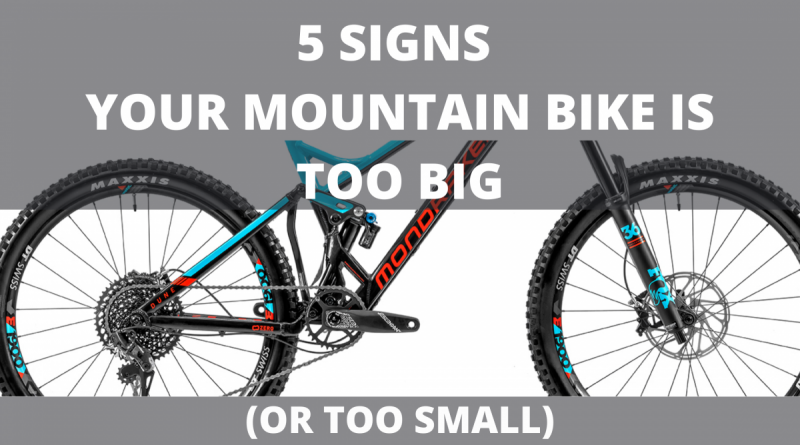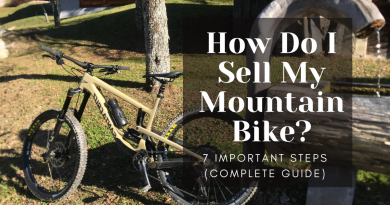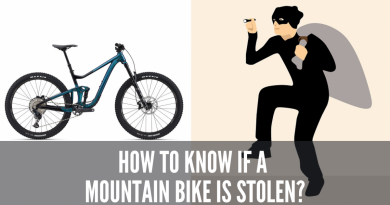5 Signs Your Mountain Bike Is Too Big (Or Too Small)
Signs Your Mountain Bike Is Too Big (Or Too Small)
How do you know if your mountain bike is too big? In this post, we look at how to determine if your bike is too big (or small), and things you can do to ensure your bike is the correct fit for you.
Well-known riders and brands advocate that longer bikes are better, which is helping to drive a trend towards longer, lower, and slacker bikes, but is this trend the best for average riders? Probably not, because longer, lower and slacker bikes are great for racers, and people riding wide, fast alpine descents, but what about the average rider, that likes to enjoy playing around in their local woods with their friends?
Mountain bike frame design is all about compromise. For example, some aspects of mountain bike frame design make a bike more stable at high speed, but also make the bike more cumbersome at slow speed. So logically it makes sense to find a middle ground, where the geometry of a bike will perform optimally in all situations. The only exception is if you’re wanting a bike for a very specific purpose – for example, if you live in the Alps, then yes, a long, low, and slack DH bike will probably be the best choice.
From my experience, I would say the average rider is more likely to find extreme geometry a hindrance rather than a benefit. So in this post, we’re going to look at ways you can tell if your bike is too big.

5 Signs Your Mountain Bike Is Too Big
We are going to look at the 5 most common signs your bike is too big:
1. Struggling in Tight Turns
Are you finding it challenging to get your bike around slow, tight turns? If your bike is too big, it can feel like you are fighting the bike to get a super high line into tight turns. Yes, you can learn to improve your technique, but if your bike is too big no matter how good a rider you are, you’re going to end up fighting your bike.
2. Lack of Front Wheel Grip
Do you find you are consistently struggling for front-wheel grip? One of the biggest issues with long bikes is that it makes it much harder to get your weight over the front wheel, which can cause the front wheel squirming in turns and a few more crashes than normal. If you run very low front wheel tire pressures, this could be because you are trying to overcompensate for lack of front wheel grip because of a bike that’s too long.
3. Challenging to Lift the Front Wheel
Do you find it hard to lift the front wheel over obstacles? Another common issue with bikes that are too long it can make it challenging to lift the front wheel up over for drops and bunny hop over obstacles. You may also find it hard to wheelie and manual a big bike.
4. Feeling Like a Passenger
Do you feel like you are a passenger on the bike? Another big issue with bikes that are too large, is that riders tend to hold on and let the bike plow through everything, rather than have the ability to put the bike where they want it.
5. Not Comfortable
Bikes that are too big can also cause a great amount of discomfort on your neck, back, knees and shoulders. If you find yourself overly stretching to reach the handlebars you will find it uncomfortable, especially on longer rides around your arms and wrists.
What Can I Do if My Mountain Bike Frame Is Too Big?
If you suspect your frame is too big, you could start with trying a shorter stem. It will surprise you how much difference 5-10mm can make. You can also get reducer headsets that will increase, or decrease the length of your bike – this can be a good option but does not work on all frames. If those don’t cut it, then you’re going to have to replace your frame. You could try posting on FB marketplace, or Pinkbike to see if anyone would like to swap for a smaller frame – as many people are following the trend for bigger bikes (so you could be in luck).
Signs Your Mountain Bike Is Too Small
Despite the trend towards bigger bikers, some people do still end up riding a bike that is too small because they have the idea a smaller bike is easier to control. So how do you know if a bike is too small?
1. Feeling Squashed
Bikes that are too small force the rider into a hunched position which reduces the amount the rider is able to move around on the bike. This can make the bike hard to corner, and move over technical trail features.
2. Feeling Unstable at Speed
When a mountain bike frame is too small it can have a narrow wheelbase, which can make the bike feel unstable, especially when going faster. When a bike doesn’t feel stable it can reduce a rider’s confidence, which can make even the easiest trails seem challenging.
3. Not Comfortable
Many riders who have ridden bikes that to small often complain of wrist, knee, and back discomfort. This discomfort is often due to the body being forced into an unnatural position. Ideally, you want to find a balance where you are not overly cramped or too stretched.
Questions & Answers
Is It Better to Get a Bigger or Smaller Mountain Bike Frame?
Ideally, you want to go for the correct size for your body size. However, if you do find yourself in between 2 sizes and you are a less experienced rider then test ride the smaller of the two sizes first. Frame sizing is not an exact science as brands can only make a small number of sizes, and every rider is built slightly differently. So if possible, always try and test ride a bike before you buy.
How Big Is Too Big for A Mountain Bike?
It’s recommended to check the manufacturer’s sizing chart and not go much bigger than the recommended size for your height, or you can use our frame size calculator for a good starting guide.
How Do I Know if My Mountain Bike Is Too Small?
If your mountain bike is feeling cramped, unstable, or is giving you discomfort then your mountain bike may be too small for you. Try our frame size calculator for a starting guide, or ask a local bike shop or mountain bike coach.
How Do You Know if A Mountain Bike Is the Correct Size?
Start by checking the manufacturers’ frame size recommendations. Also, think about whether you are feeling overly stretched or cramped when reaching the handlebars. Basically, you want to feel in a neutral position on the bike. Read through the rest of this post if you want to have a better understanding of frame sizing.
Final Thoughts
Some people are fortunate enough to fit the exact body size the manufacturers designed their sizing around, however, most people do not fit this very specific criteria. Therefore most people are often in-between frame sizes.
To make matters even more tricky, frame sizing differs a lot between brands- which means if you were a medium with one brand of bike, you could be better suited to a large on another brand of bike. The only way to overcome this is to test ride different bikes until you find a size that works for you. Once you have found a size that works well for you can take note of the key geometry numbers like reach, standover, stack, and head angle, and then aim to find a bike that closely matches these numbers.
Remember, for frame sizing, there is no right or wrong answer, it’s what works for you.
You may also like:
- Mountain Bike Frame Size Calculator, Charts, Fit & Frame Geometry
- What Is Wheelbase On A Bike? (Explained)
- XC Bike VS a Trail Bike | Which Is Better?
Paul Aston is an advocate of long, low, and slack frame design, you see his point of view on this discussion here




